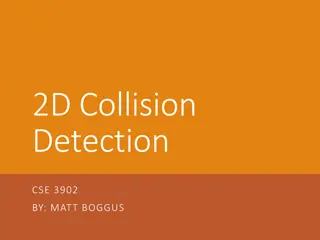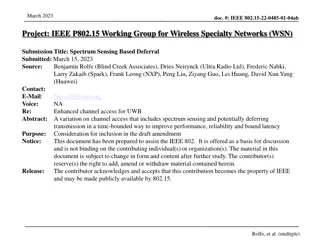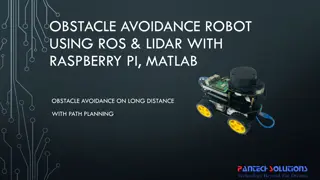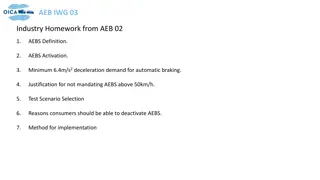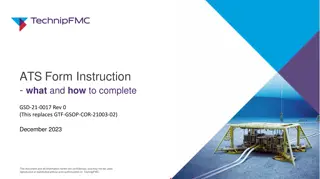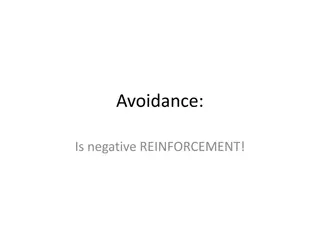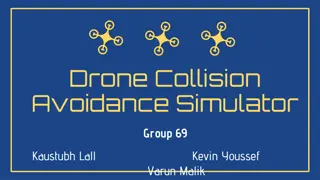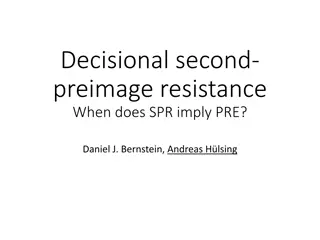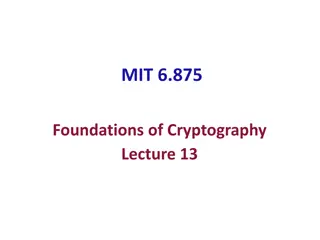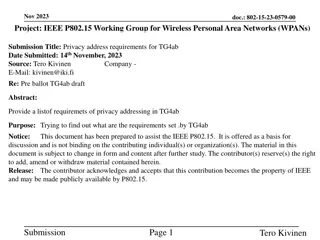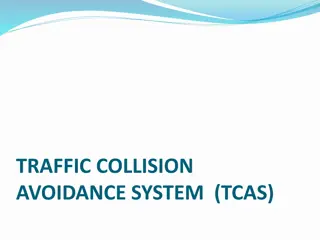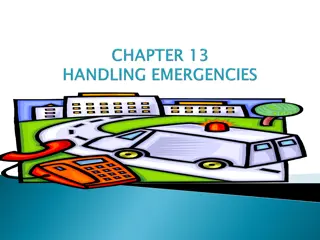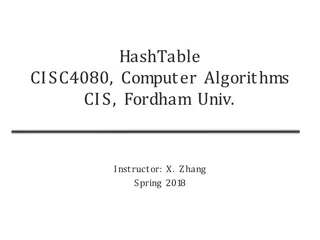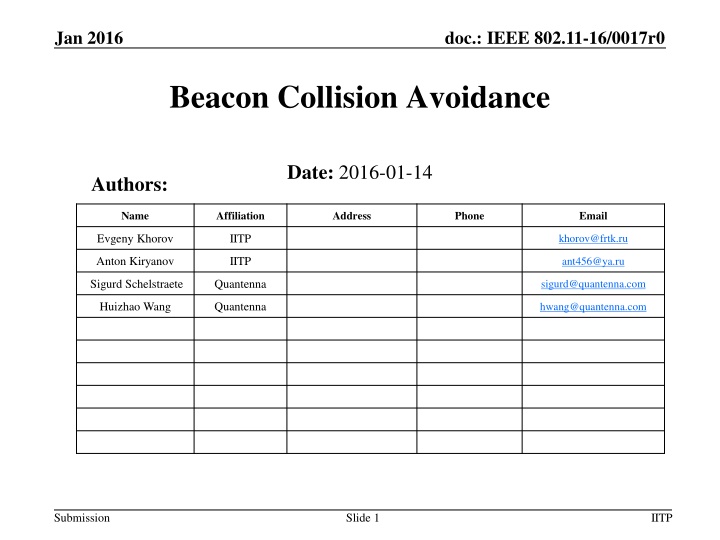
Advancements in IEEE 802.11-16 for Beacon Collision Avoidance
Explore the challenges and solutions associated with beacon collision avoidance in IEEE 802.11-16 networks through detailed analysis of hidden station problems, collision probabilities, and existing protocols. Understand the importance of collision detection, notification, and effective protocols for seamless network performance.
Download Presentation

Please find below an Image/Link to download the presentation.
The content on the website is provided AS IS for your information and personal use only. It may not be sold, licensed, or shared on other websites without obtaining consent from the author. If you encounter any issues during the download, it is possible that the publisher has removed the file from their server.
You are allowed to download the files provided on this website for personal or commercial use, subject to the condition that they are used lawfully. All files are the property of their respective owners.
The content on the website is provided AS IS for your information and personal use only. It may not be sold, licensed, or shared on other websites without obtaining consent from the author.
E N D
Presentation Transcript
Jan 2016 doc.: IEEE 802.11-16/0017r0 Beacon Collision Avoidance Date: 2016-01-14 Authors: Name Affiliation Address Phone Email Evgeny Khorov IITP khorov@frtk.ru Anton Kiryanov IITP ant456@ya.ru Sigurd Schelstraete Quantenna sigurd@quantenna.com Huizhao Wang Quantenna hwang@quantenna.com Submission Slide 1 IITP
Jan 2016 doc.: IEEE 802.11-16/0017r0 Hidden STA Problem The problem of hidden station is crucial for dense deployment. Example: AP1 and AP2 are out of range of each other, while AP1 and STA1, STA1 and AP2, AP2 and STA2 sense the transmission of each other. AP1 Beacon BSS1 STA1 Collision AP2 Beacon BSS2 STA2 The beacons transmitted by AP1 and AP2 can overlap, which results in a collision at STA1. Submission Slide 2 IITP
Jan 2016 doc.: IEEE 802.11-16/0017r0 Beacon Collision Avoidance Beacon Collision Avoidance is extremely crucial: Beacon frames contain vital information for BSSs. Beacons are transmitted without acknowledgement. If undelivered, they are not repeated. No RTS/CTS can be used to protect beacon transmission, thus beacon transmission reliability can suffer from the hidden station problem inherent to dense networks. Since beacons are transmitted periodically and various APs can have the same (e.g. default) beacon interval, having started to collide, the beacons keep on colliding during long time. Submission Slide 3 IITP
Jan 2016 doc.: IEEE 802.11-16/0017r0 Probability That a Beacon Collides With a Beacon From a Hidden AP If Beacon interval (BI) = 100 ms, beacon duration = 1 ms, then the probability that two hidden beacons collide is 1%. 20% BI=100ms 18% For N hidden APs: 16% BI=1s 14% Probability 12% 10% 8% 6% 4% 2% 0% 0 5 10 N 15 20 Submission Slide 4 IITP
Jan 2016 doc.: IEEE 802.11-16/0017r0 Collision Avoidance Collision notification AP1 TBTT Beacon Beacon BSS1 STA1 Collision AP2 Beacon Beacon BSS2 STA2 Collision Avoidance includes Collision detection, Notification, Selecting new TBTT If a STA receives beacons from an OBSS AP, it can resend information about beacon transmission time and beacon intervals to its AP. The AP uses this information for its TBTT selection and TBTT adjustment. Submission Slide 5 IITP
Jan 2016 doc.: IEEE 802.11-16/0017r0 Existing Protocols Useful for Beacon Collision Avoidance Mesh beacon collision avoidance (802.11s) Neighbor report (802.11k) Beacon report (802.11k) Submission Slide 6 IITP
Jan 2016 doc.: IEEE 802.11-16/0017r0 Mesh Beacon Collision Avoidance (.11s) In mesh networks, MBCA can be used to detect and mitigate collisions among Beacon frames transmitted by STAs (including mesh STAs, APs, and STAs in an IBSS) on the same channel within the range of 2 hops [1, Section 13.13.4]. MBCA is composed of beacon timing advertisement, TBTT selection, and TBTT adjustment. Beacon timing advertisement: Beacon timing elementis included in certain beacons, probe response frames and TBTT adjustment request frames. This element contains neighbor sbeacon transmission time and beacon interval. It is designed for MBSS (beacon timing element is sent in beacons, while in infrastructure BSSs, only APs send beacons). Submission Slide 7 IITP
Jan 2016 doc.: IEEE 802.11-16/0017r0 MBCA: TBTT Selection and Adjustment TBTT selection [1, Section 13.13.4.3] The mesh STA selects its TBTTs so that its Beacon frames do not collide with Beacon frames transmitted by other STAs in its 2 hop range. TBTT adjustment [1, Section 13.13.4.4] When a mesh STA discovers that its beacons repeatedly collide with beacons of a one-hop or two-hop neighbor and its TBTT comes later than the neighbor s TBTT, the STA adjusts its TBTT. When a mesh STA discovers that beacons from some neighbors are colliding repeatedly, it requests a neighbor with the last beacon to adjust its TBTT. Delayed beacon transmissions [1, Section 13.13.4.6] A mesh STA may occasionally delay its beacon for a pseudorandom time to discover possible beacon collisions. Submission Slide 8 IITP
Jan 2016 doc.: IEEE 802.11-16/0017r0 Neighbor Report (.11k) A neighbor report is sent by an AP and it contains information on neighboring APs that are members of ESSs requested in the neighbor report request [1, Section 10.11.10]. This request/report pair enables a STA to gain information about the neighbors of the associated AP to be used as potential roaming candidates. Neighbor report includes BSS ID, BSS ID information (e.g., capabilities), channel, etc. high overhead TSF subelement contains beacon interval. The neighbor report is transmitted only by AP, not by STA. So it cannot solve the problem if two APs are hidden from each other. Submission Slide 9 IITP
Jan 2016 doc.: IEEE 802.11-16/0017r0 Beacon Report (.11k) Beacon report [1, Section 10.11.9.1] can be requested from a STA includes BSS ID, beacon or probe response reception time, channel number, RCPI, RSNI, etc. high overhead is designed to get information about neighbor BSSs, not to avoid beacon collisions is not clear whether a beacon or a probe response transmission time is indicated does not indicate beacon interval can include optional subelements (Beacon interval can be included in a Beacon report element as an optional new subelement) Submission Slide 10 IITP
Jan 2016 doc.: IEEE 802.11-16/0017r0 Proposed Solution Since 1. Beacon Report and Neighbor Report have huge overhead and many other limitations, 2. MBCA is a ready solution with rules and signaling but it does not support infrastructure BSS, we propose to adapt the Mesh Beacon Collision Avoidance protocol for infrastructure networks. Submission Slide 11 IITP
Jan 2016 doc.: IEEE 802.11-16/0017r0 Straw Poll #1 Do you agree to add the following text in SFD: x.y.z The spec shall include a mechanism that allows an HE AP to obtain the beacon timing information of the APs in its two-hop neighborhood. This information can be used for TBTT selection and TBTT adjustment in order to prevent beacon collisions caused by hidden APs in dense deployment scenarios. Y N A Submission Slide 12 IITP
Jan 2016 doc.: IEEE 802.11-16/0017r0 Straw Poll #2 Do you agree to add the following text in SFD: x.y.z The spec shall include an adaptation of the Mesh Beacon Collision Avoidance protocol for infrastructure networks. Y N A Submission Slide 13 IITP
Jan 2016 doc.: IEEE 802.11-16/0017r0 Reference [1] IEEE P802.11-REVmcTM/D4.3 Submission Slide 14 IITP

